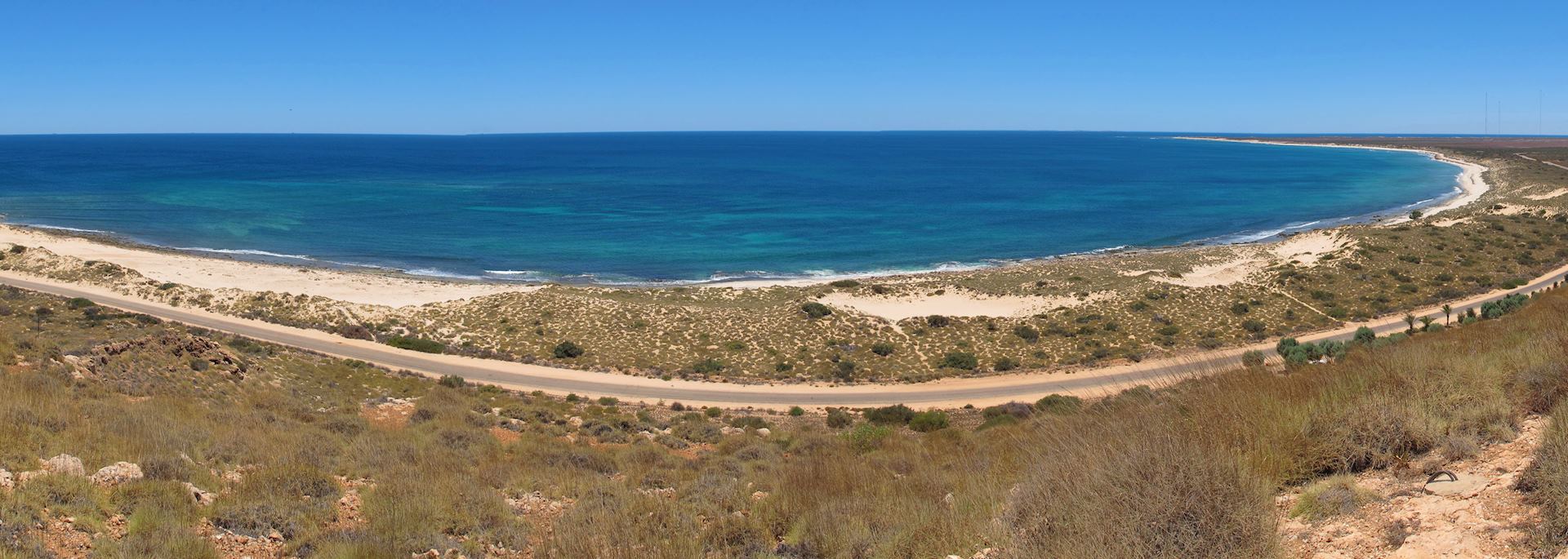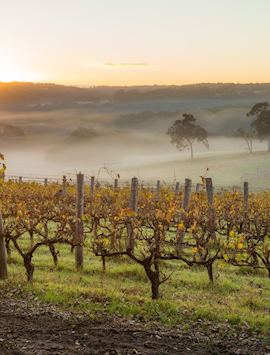By Australia specialist Vina
The drive north along Australia’s western coast, from Perth to Exmouth, takes you into desert, marine reserves, cosseted bays, and national parks bursting with geological spectacle — and, you can even snorkel with whale sharks. It’s among the finest road trips Australia has to offer.
To enjoy it, you’ve got to be comfortable with several aspects. You’re in remote country here: the road goes ever on and on, drive times are lengthy, and woe betide you if you forget to refuel (gas stations are infrequent). Places to stay are mostly low-key and self-catering. But, you’ll have access to some of Australia’s most untouched landscapes (including its most beguiling coastline) — without the crowds.
The route I’m going to describe could work as a stand-alone trip in lesser-explored Western Australia or as part of a more ambitious trip ranging across the whole country.
And, if you’re a family with young children, don’t discount this route: as long as you’re prepared for the long drives, this region has some of the best (but much less widely known) family-friendly experiences in Australia. You can do everything from observing wild dolphins at close quarters to visiting the novel Shell Beach (more on that shortly).
Road tripping Australia’s wild western coast
The vital statistics are, admittedly, daunting: this drive is well over 1,247 km (775 miles) and usually takes about 11 days. Some days, you’ll cover especially vast distances, taking upward of five hours. But, my suggested outline breaks the trip into manageable chunks, building in downtime.
Section 1: Perth to Cervantes and Nambung National Park

A four-hour drive north of the city sees you leave urban Australia behind as you enter desert plains skirted by bushland and scrub, eventually arriving in the fishing township of Cervantes.
It’s a pleasant enough little place, where you can lunch at its lobster shacks and try the local crayfish (its lifeblood).
A five-minute drive from Cervantes brings you to Nambung. The first national park on your route, its tooth-like limestone pillars thrust irregularly out of windblown sand.
Rangers will give you a map at the park’s entrance and mark out the best driving loops and lookouts. Try to linger into the late afternoon, when the majority of day trippers from Perth disperse. You’re left to wander among the peculiar formations in relative solitude, their shadows lengthening eerily as the sun sets.
You can return to Nambung the following morning or explore Cervantes’ coastline, poking your head into tiny local-surfers-only bays, before hitting the road again.
Section 2: Cervantes to Kalbarri National Park
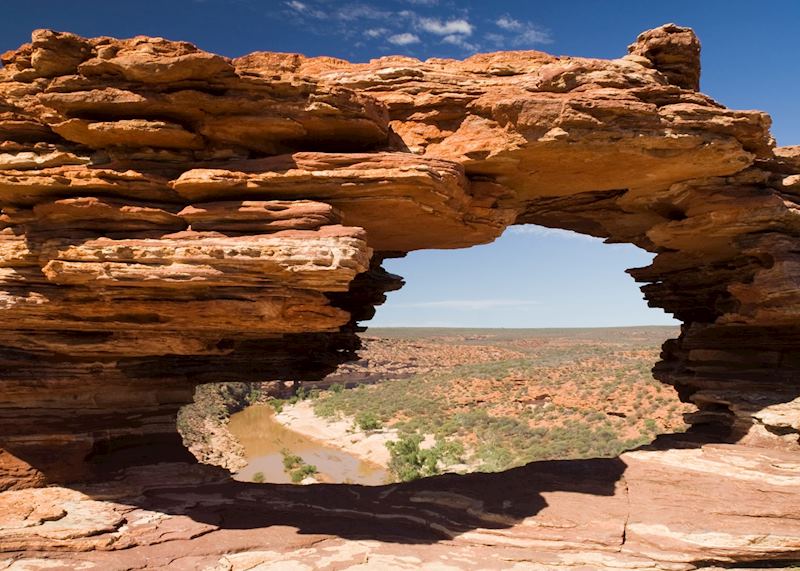
It’s another four hours north to the town of Kalbarri, but you can break up the drive in Jurien Bay for an esthetically pleasing coffee break. Think immaculate white sand, aquamarine water, and fishing boats.
Kalbarri is busier than Cervantes, but allows you to explore the national park of the same name. In contrast to Nambung, Kalbarri is a veritable oasis. Red gums and other greenery line the creeks and rivers and offset the area’s russet Tumblagooda sandstone.
Between July and November, the creeksides, gorges and clifftops are awash with wildflowers, from pink pincushion coneflowers to various orchids.
You can embark on various easy (and shaded) walking trails here. One of the most popular (and most satisfying) is the 1 km (0.6 mile) trail to Nature’s Window, a naturally formed opening in a sandstone arch, which handily frames a view over Murchison Gorge.
I’d stay two nights in Kalbarri. It gives you a day to explore the national park, and lets you steel yourself for one of the longest stretches of the journey.
Section 3: Kalbarri to Shark Bay and Monkey Mia
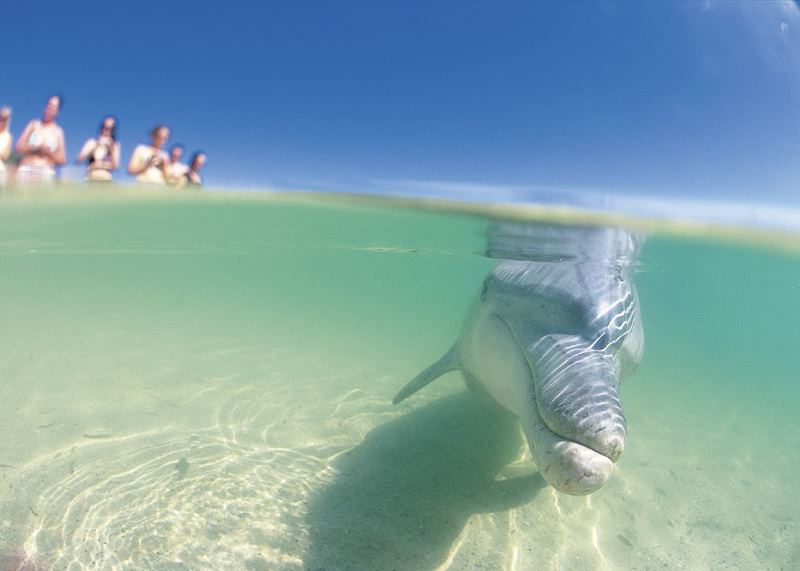
You can complete this drive in about five to six hours, but I like to make a couple of stops en route. You’re heading to Shark Bay, where Western Australia’s coastline splinters into skinny fingers of land and sparsely inhabited peninsulas. Seagrass meadows hosting a healthy dugong population lie just offshore and, despite the name, shark sightings are rare.
From Kalbarri, you veer inland and drive what I can only describe as a very long, straight, featureless road amid Outback-like red earth.
The first detour of note comes about halfway through the day’s drive, when you venture off course to Hamelin Pool, a marine reserve. It adds about 90 minutes onto your drive time, but I think it’s a price worth paying for the chance to see the pool’s colony of stromatolites, the oldest living organisms in the world. They’re representative of life on Earth as it existed more than 3,500 million years ago.
Resembling stumpy, petrified, giant mushrooms, they festoon Hamelin Pool’s shallow cyan waters, stretching far into the ocean. A boardwalk with informative panels swoops around and over the colony, which is best viewed at low tide. Handily, there’s an adjacent picnic area.
I’d also detour to Shell Beach, a good hour-and-a-half’s drive from Hamelin Pool. Here, millions of bone-white cockleshells have been deposited and compacted over the years. Starkly white, the beach throws up something of an optical illusion: bizarrely, the water reflecting on the shells makes the sea appear much farther away than it is. The untroubled water is mirror-clear and safe for children to swim in.
Your endpoint today is Monkey Mia, a tiny township on a bay known for its local wild dolphins. They nose their way daily into its low waters for a free lunch, and you can witness these controlled feedings. Although you’re not permitted to approach the dolphins, don’t be surprised if they weave and flutter around your legs in the knee-deep water. You might also see a mother with her young.
I suggest staying a couple of nights in Monkey Mia, taking time to relax before another demanding drive.
Section 4: Monkey Mia to Coral Bay
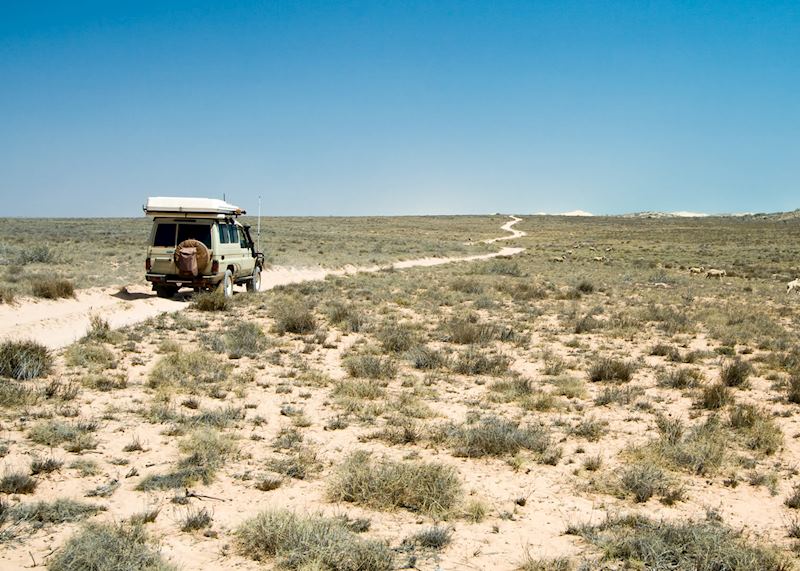
Once you’ve retraced your steps inland, you’re driving again on an almost unnervingly straight road for hours (locals nickname it the ‘ten-mile straight’). There’s little to look at apart from a few scrubby trees. Massive road trains occasionally roar past.
If the thought of six hours straight driving on this road is too dispiriting, break your journey overnight at Carnarvon. It’s a modest farming township, rich in mango plantations and mango products (you can visit plantations and try a whole range of preserves and candies).
Then, a half-hour drive away, you’ll find clifftops dotted with blowholes. They put on quite the display when the ocean is rough.
From Carnarvon, it’s a two-and-a-half-hour drive to Coral Bay, a one-street village. You can wade into waist-deep water from its beach and be immediately snorkeling on Ningaloo Reef, the fringing reef that’s the jewel in the crown of Ningaloo Marine Park.
Snorkels and fins are available to rent in Coral Bay. Despite the proximity of the reef to the town, you can see ample aquatic life here — even loggerhead turtles sometimes find their way into the shallows.
Section 5: Coral Bay to Exmouth
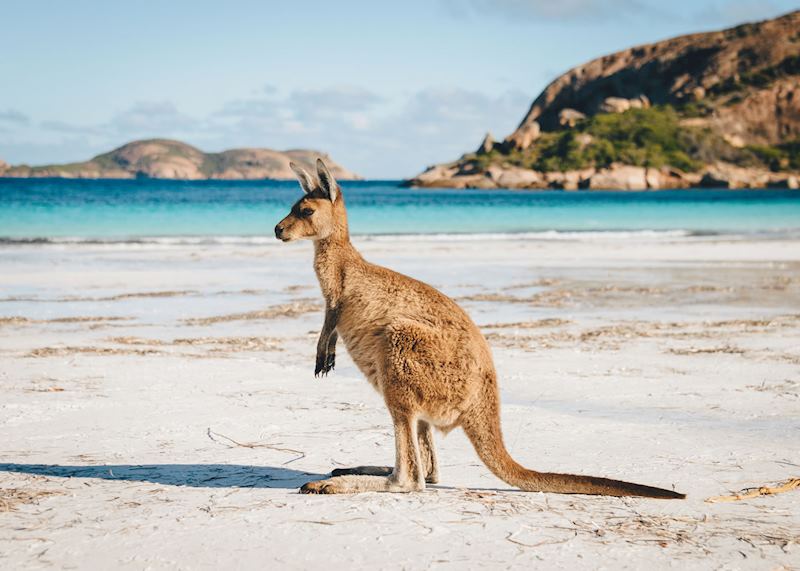
After a day or so exploring Coral Bay, you can cut across the cape (a 90-minute drive) to reach the town of Exmouth (you can also drive there directly from Carnarvon or, at a push, Monkey Mia).
Exmouth, like Coral Bay, gives you access to numerous water-based activities, including snorkeling with whale sharks. It’s also a good base for exploring Cape Range National Park (see below).
I recommend spending no less than three nights here, before dropping off your rental car at Learmonth Airport (a half-hour drive away) and flying back to Perth.
Activities and experiences around Exmouth
Snorkeling with whale sharks
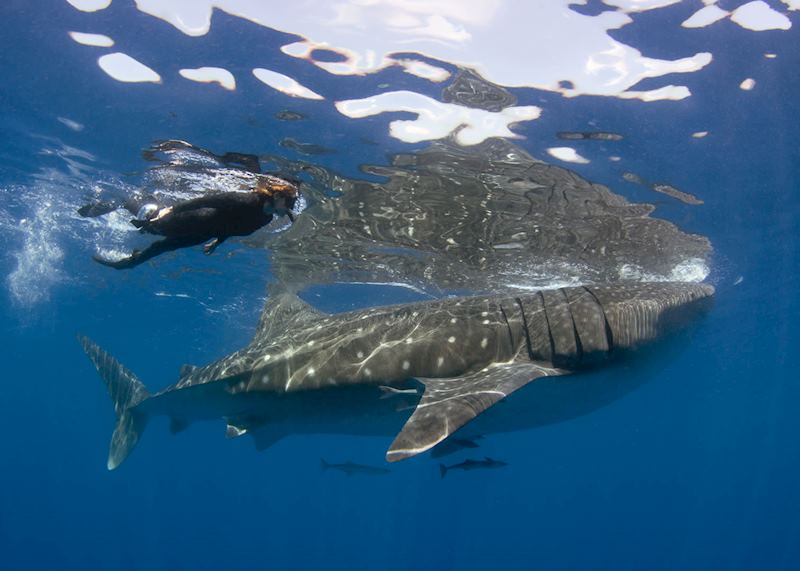
You do this in the course of a day in a very small group, which makes for a more intimate experience.
Spotter planes alert boats of awaiting snorkelers to the locations of these graceful creatures. Once you’re close enough, you get into the water to drift-snorkel with the tide, just above and behind the whale shark’s head, out of their line of sight. Guides are adept at ensuring you don’t disturb the whale shark as it glides along.
I can tell you that the experience doesn’t disappoint. No photographs can prepare you for the whale shark’s size (adults can grow up to 10 m [32 ft] long). But, what also struck me was its mottled skin. I expected it to be smooth and dolphin-like, but it looked grainy, like sandpaper, and densely textured.
Cruising or hiking around Yardie Creek, Cape Range National Park
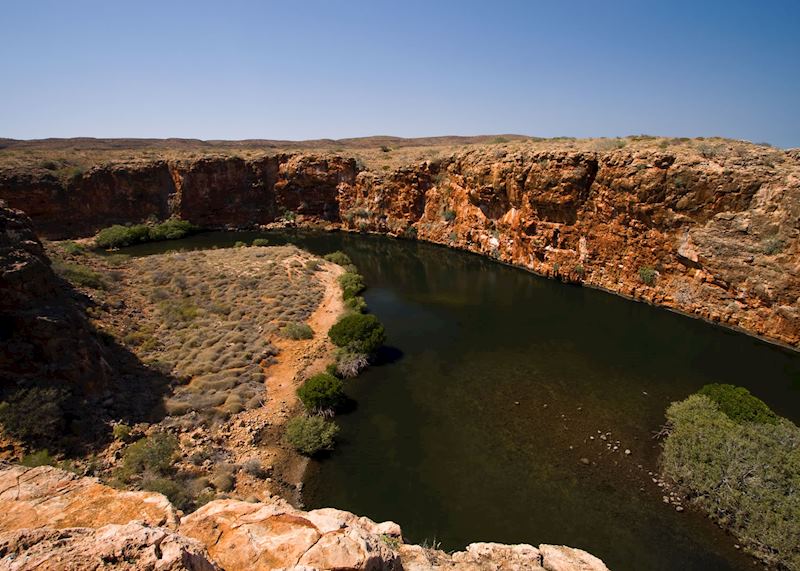
Yardie Creek is a canyon in the middle of an arid-seeming national park, Cape Range — all wind-battered limestone troughs and peaks. But, the permanent water source of Yardie has made it a gathering place for wildlife, from echidnas to eagles and even the elusive black-flanked rock-wallaby.
You can see them on walking trails or guided bush walks (sometimes with aboriginal guides), or, more sedately, on a river cruise.
I feel like the same skippers and guides have been running the river cruises since I first went on one, aged four. They’re roguishly charismatic characters, dressed in a permanent uniform of work boots and shorts. Be warned, though: they’re spinners of tall tales.
Best places to stay in Australia’s wild west

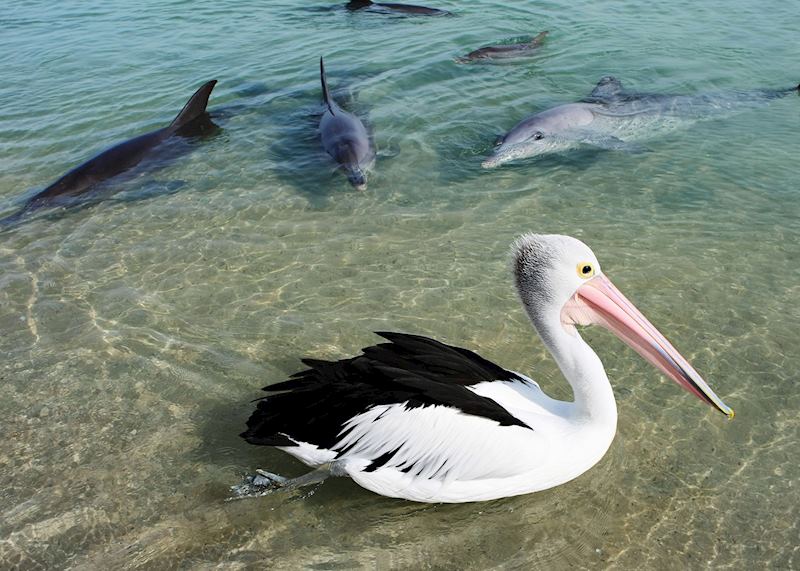
Most places to stay en route are homespun, simple self-catering affairs, but two options stand out.
The first is Monkey Mia Dolphin Resort, which has a choice of ocean-view self-catering rooms, a swimming pool and a restaurant. It also has several resident pelicans, but they’re less amenable than the local wild dolphins and waddle around disgruntledly eyeing up your breakfast.
Then, for a sumptuous glamping finale to your trip, there’s Sal Salis. Its safari-style tents sit among the pillowy sand dunes and beaches of Cape Range National Park. Many of your experiences (such as whale-shark watching and snorkeling) are included in your stay, as are your (gourmet) meals. You can even snorkel on the Ningaloo Reef before breakfast, if you so wish.
Best time to visit west-coast Australia
Time your visit between June and August for the best chances of catching the region’s wildflowers in bloom and seeing whale sharks.
Read more about trips to Australia
Start thinking about your experience. These itineraries are simply suggestions for how you could enjoy some of the same experiences as our specialists. They're just for inspiration, because your trip will be created around your particular tastes.
View All Tours in Australia
